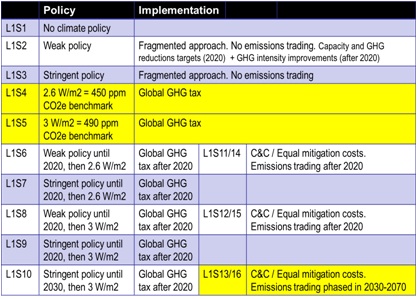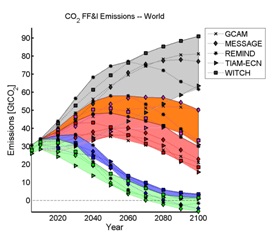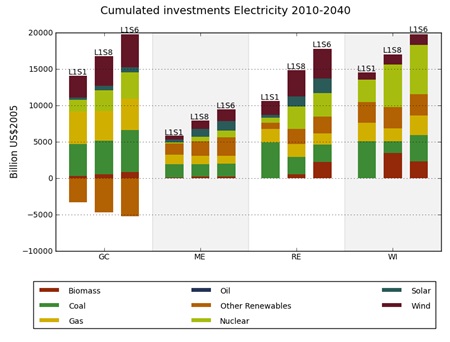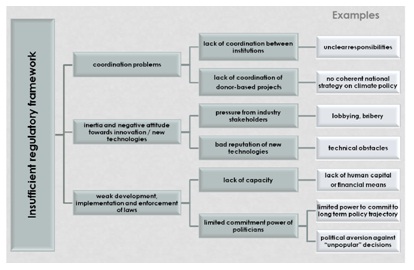From Month 1 (October 2011) to Month 9 (June 2012)
WP1: Global mitigation pathways for limiting global temperature increase below 2°C
The major aim of WP 1 is to create a set of “2°C Scenarios” which can serve as a framework for more detailed analysis in the other WPs within LIMITS. Hence, the first nine months were dedicated to formulating a study protocol reflecting the tasks in the description of work (feasibility frontier of the 2°C target, fragmented climate policies, and the influence of burden sharing regimes on regional distribution of mitigation costs), to producing first model runs, and to starting the analysis of the model scenarios. WP1 produced a comprehensive scenario set up outlined in the table below.

For the weak and stringent policy scenarios the WP1 team formulated – in cooperation with the EU FP7 project AMPERE in order to better explore synergies between FP7 projects – a comprehensive package of regional climate policies. This policy package includes both emission reduction pledges of individual countries and national technology targets like renewable energy capacity targets. The package in its weak and its stringent version is implemented in the participating integrated assessment models and enables us to study the effects of such a fragmented climate policy regime on the feasibility and the costs of reaching the 2°c target. As a next step the participating model teams (covering the five models GCAM, MESSAGE, ReMIND, TIAM-ECN and WITCH) implemented the specifications of the study protocol in their respective models, set up the runs and uploaded their model results to a database in order to facilitate the comparison between models. The figure below illustrates some first results. It shows CO2 emissions from fossil fuels and industry over the 90 years as projected by the five models. The different colours indicate the different scenario spans. The grey strip are baseline scenarios, the orange one the weak policy scenario, the red one the stringent policy scenario, and the blue and the green one are 3 W/m2 and 2.6 W/m2 scenarios respectively. The figure indicates the gap between business-as-usual and stabilization at 2°C levels, but also more importantly the gap between the 2°C target and the current fragmented regional policy pledges at both their high and lower bounds. It offers some first conclusions on the feasibility of the 2°C target and the role of fragmented climate policies.

Currently the WP1 team is undergoing an intensive work phase analysing those model scenarios in order to produce publications in time for the IPCC 5th Assessment Report. There will be a special issue on the outcomes of the LIMITS project to be produced by the end of 2012.
WP2: Implementation in major economies: Policy, institutional and financing needs
Using the preliminary results of WP 1 runs, it has been assessed to what extent energy investments and fuel expenditures are going to increase or decrease under climate policy, what financial transfers would result from different allocation of mitigation effort, and what impacts do they have on regional climate policy costs. Preliminary results indicate that investments in the power sector will increase under climate policy, but that fuel expenditures will decrease, with a compensating effect (see the figure below).

Moreover, a preliminary investigation of the financing schemes required in climate change policy scenarios have been carried out, comparing the work of the High Level Advisory Group on green climate funding.
Again, the work carried our in AMPERE on local and national policies has been expanded to create a policy data base which contains current and aspirational targets for most of the countries in the world. This DB has allowed building two realistic scenarios (called weak and stringent policies) with different targets in terms of emission reduction, renewable targets, efficiency improvements which will form the back bone of most of the modeling simulations of WP1

WP3: Implementation in major economies: Changes to energy infrastructure and land use patterns
With regards to the regional assessment and modelling of climate policy scenarios (2ºC scenarios), some scenarios will be generated for Europe, India, China, US and Japan using model expertise and insight into local policies from these regions.The analysis to be performed will be based on the framework established by the modeling work in WP1. A first exchange of views on local policies in the regions and existing scenarios has been already conducted. In WP3, the implications of the required rates of future change for the energy infrastructure in the 2ºC scenarios will be then explored.As a first step, a joint workshop with the RESPONSES project is being planned that will bring together the community of integrated assessment modellers and the community of scientists investigating historical transitions. Participants in this workshop will include outside experts on transition processes. During the workshop, an expert elicitation process will be planned to improve understanding of the transition process still further.
WP4: Multiple benefits of climate mitigation and implications for development
The estimation of co-benefits of climate policies for energy security, air-pollution, and related health impacts is the main objectives of WP4. The primary goal in this regard is a systematic comparison between different pollution-security-climate scenarios in order to assess the economic benefits of climate mitigation for these other objectives, including pollution control costs as well as benefits in terms of avoided impacts for human health and ecosystems.
The work in WP4 to this point has been laying the groundwork for running scenarios which meet pollution and energy security objectives in addition to climate objectives. Both the energy security and pollution work can be broken into two phases. Work in 2012 has focused on Phase 1 and the development of the required methods and indicators. Phase 2 will start in 2013 and will apply the methods/indicators from Phase 1 for the development of scenarios for climate mitigation co-benefit analysis.
With regards to Air pollution,
Phase 1 of the process has begun and is expected to continue until early 2013. The tasks in this phase primarily focus on model development to enhance the capabilities of the participating models to represent air pollution policies and related controls measures as well as facilitate the representation of health impacts in the TM5/FASST model.
Completed and ongoing tasks include:
1. Circulation of a questionnaire to all modeling groups to understand the scope of air pollution representation across models and identify gaps and issues for further calculation of health impacts (Completed)
2. Analysis of WP1 interim results to identify initial insights in terms of air pollution development across scenarios and the impact of climate policies (Completed)
3. Model development in FASST including a more sophisticated sub-grid parameterization of urban-rural exposure and non-linear source-receptor coefficients (Ongoing)
4. Expand air pollution reporting across modeling teams to enable sector specific and eventually spatial analysis of impacts (Ongoing)
5. Development of a proposal for representing air pollution (controls and costs) across IAM models in a homogenized manner (Ongoing)
6. Identify the methodology and process to calculate spatially explicit distributions of emissions using flexible mechanisms that account for different regional definitions of the participating IAM models.
With regards to
Energy security,
Phase 1 includes formulating a methodology and conceptual framework to evaluate and constrain energy security in integrated assessment models. Considerable progress has been made in the identification of measurable indicators. The completed and on-going tasks include:
1. Conduct a literature review on prior approaches to examining energy security in integrated assessment models and the literature on current energy security indicators (Completed)
2. Analysis of WP1 interim results to identify initial insights in terms of energy security development across scenarios and the impact of climate policies (Completed)
3. Prepare a report of using energy security indicators in integrated assessment models. Submit the report as a journal article by the end of Summer 2012 (Ongoing)
4. Expand energy security reporting across modelling teams to enable sector-specific diversity indicators and comprehensive trade analysis (Ongoing)
5. Circulation of a questionnaire to all modelling groups to understand the infrastructural assumptions and determine how and which "robustness" or "structural" concerns can be modelled and included in the modelling work (Ongoing)
6. Development of a proposal for constraining energy security across all models (Ongoing)
WP5: Policy Outreach
For the three main tasks under WP5, significant progress has been booked, in view of achieving the overall objectives of the LIMITS project.
In particular, to ensure that external stakeholders, among whom representatives of the European Commission DGs, are aware of the central research effort of the project and that they can provide feedback that can be accounted for in the project work, a first stakeholder workshop was organized by FEEM in Milan (Italy). This workshop was held as appendix to the kick-off meeting and involved the participation of key actors in the field of energy, climate, environment, engineering and policy making. As expected, it significantly improved the work of WP1.
A second stakeholder workshop will be organized by ECN, in conjunction with the third project meeting, which will focus on the policy analysis carried out in the project. A substantial group of stakeholders will be invited to react to the project policy analysis and their feedback will be turned into a policy report whose main recommendations will be integrated in the project output. This task will interact with WP2.
